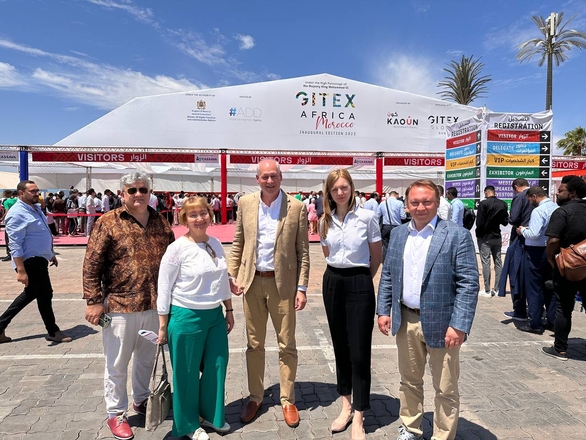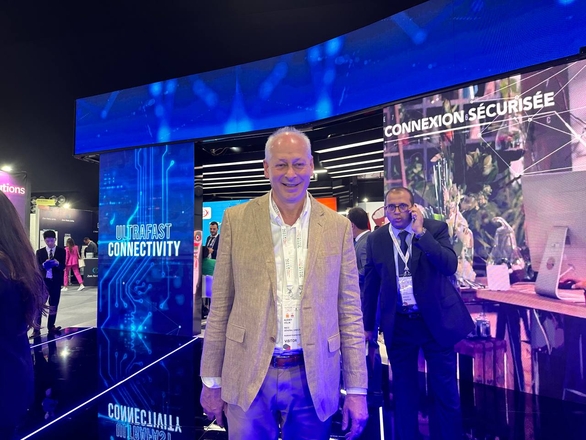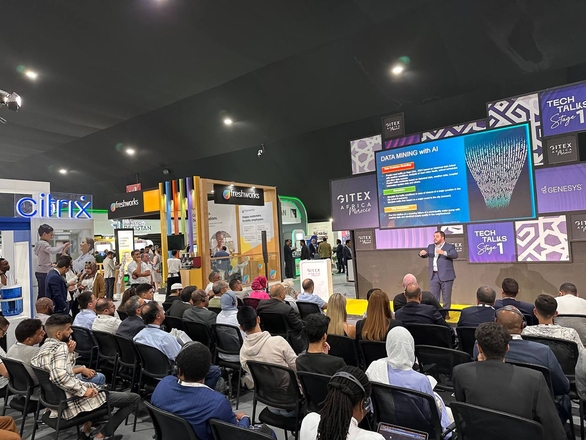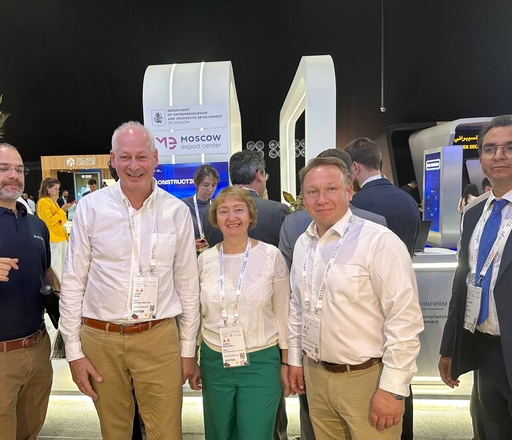Mom is Africa, dad is satellite: Gitex Africa 2023 discusses how continent digitalization is going
According to a study by the Alliance for Affordable Internet, of 45 African countries it monitors, only 10 meet the affordable Internet standard, which implies that the cost of 1 GB should be 2% or less from the average monthly income. Bridging the digital divide is a priority for all African states. The Internet connectivity is especially difficult in rural areas. Despite the fact that African countries are becoming more and more urbanized, 60% of people in Sub-Saharan Africa live in the countryside. For example, in Côte d'Ivoire 28% of the population live in areas not covered by broadband mobile communications, which is a digital divide of more than 7 million people. In Ethiopia, approximately 15% of citizens live in areas without the minimum 3G coverage, which means almost 17 million people with no access to broadband mobile communications. Satellite is the only alternative for the broadband connection of the residents in those areas. This is what the experts declared at the GITEX Africa 2023 exhibition forum.
The GITEX Africa 2023 exhibition takes place from May 31 to June 2, 2023 at the Bab Jdid exhibition center in Marrakesh, Morocco. It is the continent's largest comprehensive telecommunications event, bringing together technology companies, communication operators, national administrations, and research institutions to explore and boost the latest digital technologies. This year the emphasis is on IoT, cloud solutions and cybersecurity. "The Kingdom of Morocco is proud to host GITEX AFRICA under the High Patronage of His Majesty King Mohammed VI. We are witnessing a historic event, the first-ever edition of GITEX AFRICA, and the largest tech networking and learning business event in the African continent," said Ghita Mezzour, Moroccan Minister of the Digital Transition and Administration Reform. Mezzour added that GITEX AFRICA connects African startups and programmers with global investors, incubators, as well as public and private sector actors.
Lasina Koné, Director General and Chief Executive Officer of Smart Africa, a pan-African organization promoting the continent's digital transformation program, was one of the keynote speakers at the exhibition. Koné said that digital technologies offer new avenues for economic growth in Africa by accelerating job creation and talent development, supporting access to public services and increasing productivity and innovation. At the same time, the representative of the African organization pointed out that at the moment administrations needed help in training and attracting personnel to their space structures.
"The lack of connectivity in remote and rural regions along with insufficient data protection and high cost of African connectivity have brought new challenges to businesses, governments, and people," said Koné, who oversees the process of defining Africa's digital agenda in addition to advancing key continental initiatives. "Intra-governmental cooperation is the key enabler of digital services adoption and acceleration, while mitigating these associated challenges across the African continent."
This year, Russia was widely represented at the exhibition by the joint booths of Made in Moscow and the government of Saint Petersburg. In total, about 40 Russian companies participate in the event. The RSCC delegates who joined the exhibition were Alexey Volin, Director General, Kirill Filippov, Adviser to Director General, Alexey Vdovin, Head of Business Development Service, and other employees of the Service.
It is noteworthy that the operators presented at the exhibition focused not on pure capacity lease in their offers but on value-added services organized on a turnkey basis, taking into account the needs of each individual client: among them are comprehensive solutions for OTT platforms, vsat for corporate clients, as well as communication networks on ships and airplanes.
Connectivity is the foundation of Africa's economic prosperity
Improved connectivity and involvement of more citizens into the digital economy are critically important for social and economic transformations in Africa. According to the International Finance Corporation (IFC), a 10% increase in mobile Internet penetration increases GDP per capita by 2.5%. That means digitalization may potentially contribute about $180 billion to Africa's economy by 2025. Bridging the digital divide in the region will lead to significant economic prosperity, with an annual growth rate of 15%. Accelerating access to affordable and resilient communications networks across the African continent will revolutionize key productive and social sectors. Satellite communications will overcome the digital divide and provide affordable connectivity solutions in both rural and urban areas. The African continent has an area of 30.37 million square kilometers, which is equivalent to the area of the United States, China, India, Japan, Mexico and many European countries combined. Consequently, the cost of deploying a ground-based communications infrastructure would be exorbitant. In fact, in rural areas, satellite communication is the only viable solution for connectivity, given difficult geographical conditions such as mountains, dense forests and large bodies of water. Besides, the implementation of ground-based communications (fiber optic cables, telecommunication towers, etc.) is associated with very high capital and operating expenditures, as well as long waiting time for installation and maintenance.
One of the key trends is digitalization of the banking industry. The use of mobile banking is growing exponentially as more and more Africans use the technology to make and receive payments, trade on e-commerce platforms and access a wider range of financial services. In the African Continental Free Trade Area, satellites are the only technology that can potentially provide the instantaneous cross-border connectivity platform needed to create a single digital marketplace across the continent.
Analysts at Northern Sky Research have estimated that reaching unconnected residents (which today is 87% of the total population in Africa) would increase annual space communications revenues by more than 4.5 times in 10 years. As NSR points out, telecommunications satellites will account for 80% of the revenue growth. That said, geostationary spacecraft and VSAT technologies remain the optimal solution for Africa. New technologies, including flat panel antennas, could open up revolutionary opportunities. NSR experts believe that government investment in satellites and the ground segment is key to the development of the space economy in Africa and the Middle East.
RSCC satellites cover 100% of Africa and 81.4% of the globe. In total, the RSCC space constellation has 12 satellites, three of them working for Africa. The Express-AM8 satellite, located at 14° W and operating in the C- and Ku-bands, is used to establish communication networks in West Africa. The satellite working in C-band for the central part of the continent is Express-AM7, located at 40° E and used for trunking communications and Internet access. The Express-AM6 satellite, at 53° E, covers the entire Pan-African area. The technology of redirected and switched beams makes it possible to set up communications both within the region and between Africa and Europe.
"RSCC has got vast experience of working with the African continent; the company provides communication services for a lot of African corporate clients.
RSCC provides broadband connectivity for ships and airplanes that link Africa with the rest of the world. And we are ready to expand our partnership with clients in Africa", said RSCC Director General Alexey Volin. He also added that RSCC satellites are used in corporate, banking, transportation sectors, in agriculture, and in emergency response activities. Besides, satellites play an important role in delivering video content, TV and radio broadcasting, because they are great for meeting customer needs anytime, anywhere.
Regional operators compete for Africa
Highly noticeable was the absence of most American and European giants at GITEX, as well as the dominance of Chinese, Turkish companies and regional African operators. Traditionally, the strongest competition for the space market on the continent is between Morocco and Algeria.
Morocco is a country that has invested heavily in the aerospace sector in recent years. As part of these efforts, the Moroccan government is working to attract foreign investment and develop skillful workforce to create a sustainable aerospace industry. The government has also invested in infrastructure development, including the creation of aerospace industry clusters such as the Midparc free zone near Casablanca. Morocco has established strong partnership relations with leading aerospace companies: Boeing, Airbus, Bombardier and Safran, who have created production facilities in the country. These partnerships not only facilitated technology transfer, but also increased the overall competitiveness of the Moroccan aerospace sector.
Maroc Telecom, represented at the Gitex exhibition, is the main provider of telecommunications services in Morocco. But it also operates in 11 countries in Africa, including Benin, Burkina Faso, Central African Republic, Cote d'Ivoire, Gabon, Mali, Mauritania, Niger and Togo. Today the company has more than 74 mn mobile, fixed-line and Internet subscribers. It has achieved this figure mainly thanks to its subsidiaries in sub-Saharan Africa – where data transfer and mobile money services are growing faster than in Morocco.
UAE-based e& company increased its stake in Maroc Telecom by 4.7% to 53% in 2021. Thus, its main shareholders are the Etisalat Group and the Kingdom of Morocco (22%). The firm's first quarter 2023 profits were up slightly, by 1.8%, and the revenue was up 7.3%.
Another competitor for Africa is Algeria. Alsat, the Algerian space agency, has chosen China as its strategic partner, with which it signed its second strategic agreement on space cooperation in November 2022. This is not surprising, since the PRC is Algeria's main trading partner and overtook the previous leader, France, in terms of trade volumes in 2013.
The heavy class spacecraft (5,225 kg) was created and launched by a consortium of Chinese space companies led by the China Academy of Space Technology (CAST). The satellite is located at the orbital position of 24.8° W, its coverage area includes all of North Africa. Alsat has made serious investments in the ground segment, too: it has created a satellite broadcasting center and central stations for the management of Ku- and Ka-band VSAT networks.
Satellite is not only the fastest but also the cheapest way of connectivity in Africa
Africa has the most expensive Internet in the world. The Alliance for Affordable Internet states that Africans pay an average of 8.8% of their monthly income to buy 1 GB of data, compared to 3.6% in Latin America and 1.5% in Asia. In Chad, the Democratic Republic of Congo, and the Central African Republic, 1 GB cost of up to one-fifth of a month's earnings was recorded. In addition to the costs, there is also the problem of coverage: one in four Africans still does not have access to mobile broadband, and half of those who do have it do not use the Internet.
Space technologies and hybrid solutions using satellites on NGSO and GEO are designed to make communications in Africa more affordable. Eutelsat, Iridium, Boeing, Orbcomm, GlobalStar, OneWeb and Telesat are several companies working to make satellite communications less expensive. RSCC with its Express satellite constellation also makes a significant contribution to reducing the cost of satellite communications. The upcoming launch of new spacecraft with digital payloads is expected to make satellite communications less expensive and more efficient.
The satellite communications market accounts for the bulk of the volume of the African space and satellite industry. In turn, a significant share of this income comes from satellite pay TV services, which are dominated by the major DTH operators: DSTV, Canal+ Afrique and StarTimes. Satellite video delivery is perceived in Africa as a cost-effective and easily scalable technology. At the moment, RSCC is planning to participate in the distribution of five Ethiopian cable TV channels.
And SES announced that Africa's satellite TV viewer base has grown by 3 million people over the year. In Ethiopia, for example, SES delivers TV channels through its partner Ethiosat using its medium-orbit constellation to 90% of homes with television sets. In 2021, the operator began signing O3b contracts in Africa, followed by a transition to O3b mPower. And in 2022, Orange, in alliance with Senegalese cellular operator Sonatel, opened the first O3b mPower gateway in Africa. Orange became the first global operator to integrate SES's mid-orbit constellation into its network to meet the African market's request, launching with the service in the Central African Republic.
Another satellite operator represented at Gitex Africa is Eutelsat. Eutelsat's key orbital position for TV channel distribution in sub-Saharan Africa is the point 36°E well-known in Russia. All the leading African direct TV-broadcasting platforms broadcast from it, covering 8 million households. The operator's next key business was Eutelsat Konnect Africa – providing broadband access services using an ultra-high bandwidth satellite. In June last year, the operator joined the Kigali declaration and the Partner2Connect digital coalition, pledging to connect 1 million unconnected sub-Saharan Africans by 2027. In January of this year, the operator announced the connection of 200,000 subscribers through collective Wi-Fi Konnect access points. In September 2022, Liquid Intelligent Technologies, a provider operating in 27 African countries, signed a service agreement with Eutelsat Konnect and began building its first sub-Saharan hub.
In addition to individual Internet access, there is high demand in Africa in the corporate and government sectors. While in coastal Africa you can still count on FOCL and terrestrial radio access, when you go deep into the continent, satellite is almost the only technology available. Therefore, satellite operators consider Africa a promising market, although its development is complicated by the extremely low purchasing power of the population.
Space industry as an enabler to improve the quality of life
Africa's space industry was valued at $19.49 billion in 2021 and is projected to grow 16.16% to $22.64 billion by 2026. The industry employs more than 19,000 people across the continent, most of whom – 11,000 – work in government organizations and enterprises. African countries allocated $534.9 million to national space programs, a 2.24% increase over 2021.
Africa's space industry is seen as one of the most influential factors in improving the quality of life and achieving a number of UN sustainable development goals in particular. High-skilled jobs are created, and this encourages young people to get an education and look for jobs in STEM. There are 272 space startups working on the continent.
The activity of space industry players in Africa demonstrates their desire to maximize the use of space technologies to solve the pressing economic and social problems of the continent.
"One of the objectives of Gitex is to take full advantage of digital opportunities and develop a digital economy", the CEO of Morocco's Digital Development Agency said during a speech at Gitex. "We need to invest in skills development to accelerate innovation and growth in Africa Moreover, more than 250 investors are expected to discuss ways of fully exploiting the potential of this sector".
Satellites for agriculture
In Africa, the following countries were able to acquire and launch their satellites: Algeria, Angola, Egypt, Nigeria, Mauritius (together with the regional organization RASCOM).
Satellite national projects tend to focus on remote sensing of the Earth because governments are very interested in controlling natural resources, farmland, and preventing natural disasters. The remote sensing market in Africa is expected to grow at a rate of 8.6% per year from 2022 to 2029.
The Taifa-1 satellite, designed and built in Kenya, was launched in April 2023 and will work for agriculture, supplying data for crop yield forecasting. More than half of Africa's population lives from agriculture, and the continent accounts for two-thirds of the world's uncultivated arable land. This is why any applications that increase the output of agriculture are in high demand. For end users in Africa and for large agricultural holdings on the continent, the experience of RSCC in high-precision positioning for the farming may be of interest. The company is testing its own customer navigation station prototype on agricultural machinery with a parallel driving system. The tests involved devices for transmitting corrective information with a positioning accuracy of 2-3 cm in the static and 5-7 cm in the dynamic. In the future, the project can be scaled to other countries, too.





